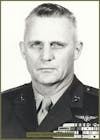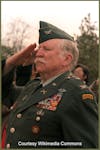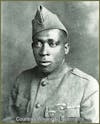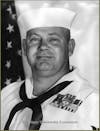US Air Force Sgt. John Levitow: Unbelievable Heroism during the Vietnam War
USAF Sgt. John Levitow displayed uncommon valor while serving aboard Spooky 71, as a loadmaster during the Vietnam War. Badly wounded and facing certain death, John heroically pushed away his fears and saved the nine men abo...
USAF Sgt. John Levitow displayed uncommon valor while serving aboard Spooky 71, as a loadmaster during the Vietnam War. Badly wounded and facing certain death, John heroically pushed away his fears and saved the nine men aboard the aircraft. For his actions that day, John earned the Medal of Honor and I am honored to tell you his story.
Please visit our website to learn more about other American Heroes.
www.dutyandvalor.com
Sources:
wikipedia.org
af.mil
nationalmuseum.af.mil
malmstrom.af.mil
amc.af.mil
homeofheroes.com
Thank you for listening to Duty & Valor!
Music by Amelie Leclerc. Artist's other music can be found here.
Please follow us on your favorite social media site.
Facebook
Instagram
Twitter
YouTube
Welcome back everyone. On today's episode of Duty & Valor, you’ll hear the story of a man who chose a military role that would put him in harm's way. A man who fulfilled a promise to a fellow airman to cover for him after being sick. A man who put pain and fear aside to save the lives of nine crewmen on his aircraft. This is the story of Medal of Honor Recipient US Air Force Sgt. John Levitow.
John was born in Hartford, CT. on November 1st, 1945 to parents Marion and Lee Levitow. Though he always wanted to join the Navy, John enlisted in the Air Force when he was 21. Initially trained as a civil engineer, he would eventually cross train as a loadmaster. He was stationed at McGuire Air Force Base in NJ when he was told that he was being sent to Vietnam.
I couldn’t find too much written about his time in combat, but on February 24th, 1969, John, then an Airman First Class assigned to the 3rd Special Operations Squadron, would exhibit uncommon valor that saved the lives of nine men.
That night, John filled in for another airman as the loadmaster aboard Spooky 71, an AC-47 Gunship that was sent to aid the soldiers of the Army base at Long Binh in South Vietnam. Spooky 71 had a crew of nine and was piloted by Major Kenneth Carpenter. For four and a half hours he piloted the gunship over the battlefield while the gunners fired on enemy positions with its 7.62mm miniguns and dropped 3 foot long, 27 pound, Mark 24 Magnesium flares. These flares slowly fell to the ground under parachute, would burn for 2 and a half to three minutes, and were used to illuminate enemy positions, allowing ground forces to make tactical decisions on a battlefield.
At approximately 2300 hours, Major Carpenter received word that American forces, who were just south of Long Binh were under a heavy mortar attack. They made their way to the coordinates and began firing on enemy positions. On its initial attack, the crew of Spooky 71 destroyed two mortar positions and located a third. Major Carpenter prepared to make a return pass, banking the gunship hard.
John grabbed a flare, set its timer, and handed it to Airman First Class Ellis Owen who waited for word to throw it out over the enemy positions. They were flying low while turning back around, only 1,000 feet off the ground putting them directly into the path of a 82mm mortar round.
The explosion caused by the mortar put a 2-3 foot hole in the right wing of the gunship. This explosion also sent approximately 3,500 pieces of shrapnel into the cargo hold, striking all four men there. While Major Carpenter tried to regain flight controls, the four men were all thrown to the floor, badly injured. John, who was hit by forty pieces of shrapnel, struggled to make sense of what was going on. He could feel pain throughout his body and his badly wounded legs were numb. He observed that another airman had fallen by the open doorway. Not even knowing if he could walk, John had to pull himself up and he took small steps toward the door. This wasn’t easy for him, not only due to his injuries, but also because the plane was bouncing and shuttering heavily.
John made it to the other man. He knew that there was a real risk of both men falling out of the doorway, but John carried on. He grabbed ahold of him and pulled them backwards, away from the danger of the open door.
At this time, John saw smoke and became aware of the next danger. Fire aboard the plane could ignite the fuel, ammunition, or flares, causing a catastrophic explosion. As he made his way toward the smoke, reality hit John. The smoke wasn’t coming from a fire that could be extinguished, rather it was coming from the flare that he had set the timer on just moments earlier.
These flares have a pin that is attached to a ten foot lanyard which would allow the flare to begin its firing process as it fell to the ground. However, the violent shaking of the plane sent the flare beyond ten feet and its firing process began. In less than 20 seconds, a series of explosions would ignite it, and since these flares burn at 4,000 degrees Fahrenheit, John knew that inaction wasn’t an option.
With the plane still bouncing, John struggled to make his way to the flare canister. Just as he reached for it, the plane again turned. To his dread, John watched it roll away from him. Putting his pain aside, he continued toward it. And for a second time, the flare eluded his grasp and rolled away yet again.
Growing increasingly weakened due to the shrapnel wounds and loss of blood, John didn’t want to risk not being able to grab the flare on his third attempt. This time, he threw his body on the burning flare, finally getting and maintaining control of it.
While still holding the canister to his chest, he made the painful crawl to the open cargo door at the back of the plane. In what must have felt like an eternity to John, he made it to the open door and pushed the flare out just as it exploded.
Major Carpenter was able to get Spooky 71 to a nearby airstrip where they were able to make an emergency landing. After landing, John and the other injured crew were brought to an aid station to be treated for their serious wounds. Major Carpenter was unaware of John’s act of valor until after they landed, and it didn’t fully set in until daylight when he saw the trails of John’s blood covering the back of the cargo hold.
Major Carpenter went on to say “I’ll never know how Levitow managed to get to the flare and throw it out. In my experience, I have never seen such a courageous act performed under such adverse conditions.”
John recovered from his wounds and would go on to fly 20 more combat sorties, giving him 201 during the war, before his enlistment ended six months later at the rank of Sergeant.
For his actions that day, Airman 1st Class John Levitow was awarded the Medal of Honor. On May 14th, 1970, John was presented the medal by President Nixon at a White House ceremony with other recipients. John became the first enlisted Air Force man to receive this honor.
After leaving the Air Force, John worked for CT’s Veterans Administration and later became assistant to the Commissioner there.
John Levitow died on November 8th, 2000 at the age of 55 and was buried at the Arlington National Cemetery.
His legacy lives on in the Air Force with a C-17 Globemaster bearing the name “The Spirit of John L. Levitow”. Also, according to an article from the Air Mobility Command, “the John L. Levitow Award is the highest award for enlisted Professional Military Education in the Air Force
and is presented to the student who demonstrates the most outstanding leadership and scholastic achievement throughout Airman Leadership School, Non-Commissioned Officer Academy and Senior Non-Commissioned Officer Academy.
Sergeant John L. Levitow's spirit and unwavering courage exemplify the essence of heroism. In the face of relentless adversity he was a beacon of selflessness and bravery. John Levitow's heroic sacrifice and uncommon bravery will forever be etched in the annals of Air Force history, a testament to the enduring power of one individual to make a difference against all odds.
Thank you for listening to this episode of Duty & Valor. To read more about this week’s hero, check out the sources used in today's episode in our show notes and at dutyandvalor.com.
If you want to listen to our episodes early, we release new episodes on our YouTube channel of the same name on Fridays at 5pm. Also, on our channel we release daily YouTube shorts that highlight our Nation’s heroes, most of whom haven’t been featured on the show yet.
Be sure to like, follow, and share our episodes and please join us for our next episode, where we'll be sharing the inspiring story of another American hero who served with pride and lived with humility.




















